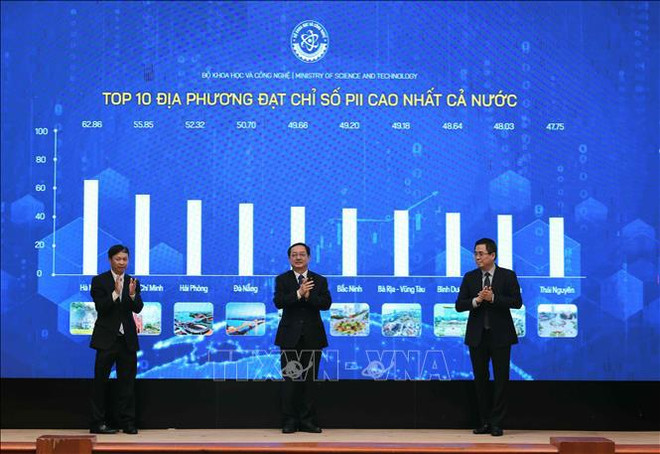 Minister of Science and Technology Huynh Thanh Dat (centre) and other officials at the launch of the Provincial Innovation Index 2023 on March 12 (Photo: VNA)
Minister of Science and Technology Huynh Thanh Dat (centre) and other officials at the launch of the Provincial Innovation Index 2023 on March 12 (Photo: VNA)The index aims to provide a general panorama of the socio-economicdevelopment model based on science, technology, and innovation of each provincial-levellocality. It points out the strong and weak points, potential factors, andnecessary conditions for boosting the science, technology and innovation-baseddevelopment in each locality.
Minister of Science and Technology Huynh Thanh Dat said thatsince 2017, the Global Innovation Index (GII), published annually by the WorldIntellectual Property Organisation (WIPO), has been used by the VietnameseGovernment as an important source of reference to build and issue innovationfacilitation policies.
Assigned by the Government, the MST has coordinated with WIPOand relevant agencies to design and pilot the PII in 20 localities in 2022 tomeasure their innovation capacity and performance. The PII has been officiallyapplied nationwide since 2023, he noted.
Theminister described the PII as useful as it supplies a scientific and practical foundationfor agencies, organisations, and leaders of localities to build and implementpolicies to boost socio-economic development based on science, technology, and innovation.
He expressed his belief that the PII will also be helpful forinvestors to learn about the investment climate, conditions, and resources forproduction and business activities in different localities.
Accordingto the PII 2023 results, the top 10 on the rankings consist of Hanoi (62.86), HoChi Minh City (55.85), Hai Phong city (52.32), Da Nang city (50.70), Can Tho city(49.66), Bac Ninh province (49.20), Ba Ria - Vung Tau province (49.18), Binh Duongprovince (48.64), Quang Ninh province (48.03), and Thai Nguyen province (47.75).
Deputy Minister of Science and Technology Hoang Minh said the results match thesocio-economic development status of localities. The ones ranking high on thelist boast favourable natural and geographical conditions (mainly in the RedRiver Delta and the southeastern region), industry - construction and servicesectors accounting for large proportions of their economies, many industrialparks, developed infrastructure, and strong scientific, technological, andinnovative activities.
Meanwhile, the worst-performing ones are localities with modest socio-economicdevelopment along with natural and geographical conditions unfavourable for thedevelopment and application of science, technology, and innovation (mainly inthe Central Highlands and the northern midland and mountainous region)./.





























